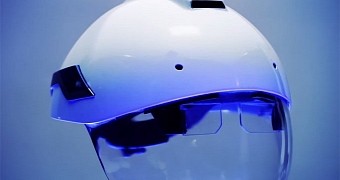So far, Google Glass and all other augmented reality headsets have been advertised as entertainment and gaming devices, or something that can “augment” your life with live information on everything in your line of sight.
In the end, however, it's still hard to tell what exactly augmented reality will really be used for once it gets off the ground.
Sure, getting live pop-up messages about, say, Mount Rushmore is nice, but not that helpful unless you're on a trip. And most people aren't likely to go vacationing more than once or twice a year.
And you don't really need pop-up info on things you interact with every day, not to mention that listening to music and taking calls is done easily enough with any pair of mildly competent headphones.
Now, though, Los Angeles-based startup DAQRI has proposed an actual, good use for augmented reality: the working class that performs manual labor. Blue-collar workers, in other words.
Behold, the DAQRI Hard Hat
Normally, a hard hat only protects you from falling debris, like bricks, in construction sites. Or falling tools and various other hazards.
DAQRI has decided to enhance the hard hat with features you would normally need a laptop for. Just add some sensors, two Qualcomm Snapdragon processors, and transparent screens instead of lenses and voila! A new dimension is added to your life.
The Hard Hat can lower the lens over your eye, or both eyes, whenever you need, say, information on tools or materials you're about to handle.
The Hard Hat can also be synced to your smartphone and smartwatch, interposing larger pop-up windows for the functions you decide to scroll through.
The overlays are not even all that fancy. Simplicity and ease of use were valued over flashy elements, while staying pleasant to view. Moreover, the DAQRI Hard Hat is said to have 360-degree camera vision with low-light visibility.
Moving on, all the tracking and alignment tasks are handled by the large sensor bar located across the brow, plus the ability to share information with co-workers at any time, provided they, too, use similar hard hats.
The future is now
DAQRI says its helmet has the most computing power ever seen in a wearable. A large part of this is the size (a lot of hardware can be crammed in the hat, unlike, say, a smartphone or a small pair of thin-rimmed glasses.
The company decided to go one step further, however, and invented its own software, called IntelliTrack.
Of course, all these perks come at the expense of thousands of dollars (no one is sure of the price yet), but large construction, excavation, mining, and archeology companies might just consider them worthwhile investments anyway. We'll see in about a month, when the helmets hit the market.

 14 DAY TRIAL //
14 DAY TRIAL // 